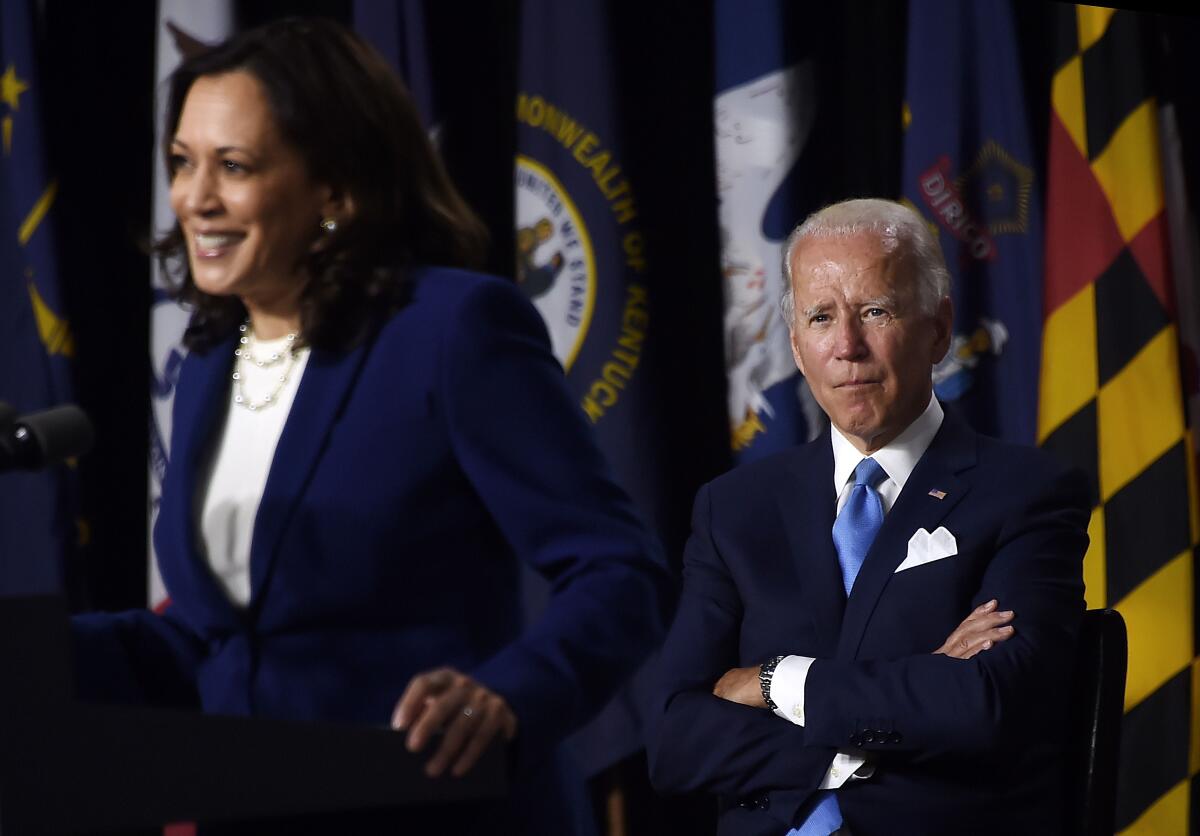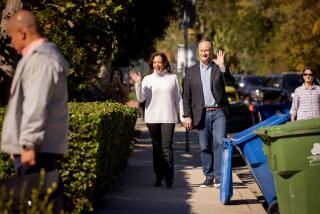For Kamala Harris, a shifting role: Fewer public events with Biden

In their first two months in the White House, President Biden and Vice President Kamala Harris were practically inseparable — Harris traveled with Biden to the Pentagon, sat in the Roosevelt Room when he met virtually with a foreign leader and delivered her own remarks on the administration’s priorities.
The proximity fueled a sense that she would be part of an unusual partnership, “the Biden-Harris administration,” as it was branded.
But nine months in, Harris’ schedule reflects the life of a more conventional vice president, one who sees the president less often and spends more time selling the administration’s agenda in roundtables and day trips to reservoirs and classrooms, according to an analysis of her public events by The Times.
Only about a fifth of the activities listed on Harris’ public calendar in September and October have involved Biden, compared with roughly three-quarters of them in January and February. This month, Harris has had seven activities with Biden on her public schedule, six of them behind closed doors. At least some of that shift is the result of a decline in COVID-19 restrictions, which kept the leaders closer to Washington in the early months.
The lone public event this month with Biden came Thursday, when Harris delivered remarks to celebrate the 10th anniversary of the Martin Luther King Jr. Memorial on Washington’s Mall.
In the prior two months, Harris attended one public event with Biden, a wreath-laying ceremony at the Pentagon on Sept. 11. Harris and Biden traveled at separate times that day to commemorate the flight that crash-landed in Shanksville, Pa., even as both paid their respects.
Harris came into her position with unique expectations as a groundbreaking politician serving the oldest president in history and one who had himself served as President Obama’s No. 2. Biden in the 2020 campaign told donors he was a “transitional candidate” who was seeking “to get more people on the bench that are ready to go in.” The implication, to some, was that Harris would be groomed in the event the 78-year-old Biden either could not fulfill his term or declined to run for reelection in 2024.
However, White House officials and Harris’ allies say it’s misleading to read too much into the scheduling shift, or to even call it that. They point out that schedules ebb and flow — Harris and Biden were together more often in July and August, a period that included public remarks after the Senate passed an infrastructure bill and a series of private briefings during the chaotic withdrawal from Afghanistan. Early in the administration, the officials say, the pair also spent time with each other out of necessity as the nation grappled with a pandemic that severely restricted travel and the size of public events.
The needs have now changed. With more people vaccinated and its legislative programs in jeopardy, the White House has launched an all-out effort to pass its agenda. That means Harris and Biden are frequently speaking to different groups, sometimes in different states, on the same day.
“I don’t really think there’s a whole lot of space between them,” said Bakari Sellers, a co-chair of Harris’ presidential campaign and a CNN political commentator who has remained a close ally. “She’s just being rolled out more.”
White House officials said some closed-door meetings and briefings do not make it onto Biden’s or Harris’ official schedule, which does not reflect the full breadth of either figure’s daily activity.
“The vice president keeps a busy schedule doing the work of the administration and always in support of the president,” said Sabrina Singh, a spokesperson for Harris. “Sometimes those events are together, other times apart. Sometimes she is on the road amplifying the agenda of the administration and highlighting the importance of Build Back Better.”
Andrew Bates, a spokesman for Biden, added that “thousands of factors” affect their schedules and that it’s common as administrations progress to dispatch the top leaders to different places for efficiency.
“They have a partnership in the mold of the Obama-Biden relationship,” he said.
Whatever the reasons the two have spent more time apart, the perception of Harris’ clout in the administration is in part tied to her proximity. Biden and Harris have said repeatedly that she would be “the last one in the room” on important decisions.
“The vice president’s power and influence is largely derived from their access to, and relationship with, the president,” said Joel Goldstein, a scholar who has written two books about the vice presidency. “That makes the vice president seem more authoritative to other leaders.”
Goldstein said he is not surprised that Harris’ publicly announced events with Biden have declined, after she spent the early months seeking to “credentialize” herself by being seen with Biden. For modern vice presidents to be effective, he said, they have to balance face time with the president and visibility elsewhere.
This month, for example, Harris traveled to Lake Mead in Nevada to discuss climate change and the drought — key components of Biden’s legislative agenda. She also flew to Newark to tour a COVID-19 vaccination site, part of the administration’s effort to convince more Americans to protect themselves from the disease. Next month, she is heading to Paris, her third foreign trip after traveling to Latin America and Asia.
“Later on, once you develop an agenda, it’s predictable that you’re going to be outside trying to sell it,” Goldstein said. “She’s trying to mobilize support for what the administration is doing.”
The lack of public events with Biden may contribute to an overall sense that Harris is not as visible as she was initially. The trips and the roundtables generate less media coverage than the events with Biden. Her standing in polls, with an average of about 42% of voters viewing her favorably, has generally trailed the president’s.
Overall, about 40% of her nearly 500 events have been with Biden, including scores of publicly disclosed lunches and meetings involving the economy, infrastructure or COVID-19. She has also received the President’s Daily Brief — the nation’s classified intelligence summary — more than 60 times with Biden in the Oval Office. This regular briefing accounts for about a third of all her events with Biden, according to the analysis.
As in every administration, Biden and Harris have their own teams of advisors, which can complicate how they gel as leaders. Biden, who was first elected to the Senate in 1972, has had a coterie of advisors for decades while Harris has a small group of people that is largely new to her.
The former rivals for the Democratic presidential nomination were not especially close, and had to overcome friction on the debate stage, when Biden chose her as his running mate.
A former Harris advisor, who requested anonymity to discuss the sensitive topic, said he remains concerned by an apparent lack of trust between the Biden and Harris operations and by the sense that “she hasn’t been given any all-star portfolio,” a criticism that White House officials dispute.
In addition to selling Biden’s economic and climate agendas, Harris is spearheading efforts to curb Central American migration, which remains at highs not seen in decades, and to lead the fight for voting rights, an area in which congressional Republicans blocked action on Wednesday for the third time this year. White House officials say the tough assignments are signals she has gained trust, while some supporters and outside analysts grumble that they are political losers.
Kevin Madden, a senior communications aide in Republican Sen. Mitt Romney’s two presidential runs who is now an independent, said he believes the White House has not figured out how best to deploy Harris.
“Part of the problem seems to be that the Biden-Harris relationship is a political partnership that’s still ripening,” he said.
Data and graphics journalist Maloy Moore contributed to this report.
More to Read
Get the L.A. Times Politics newsletter
Deeply reported insights into legislation, politics and policy from Sacramento, Washington and beyond. In your inbox three times per week.
You may occasionally receive promotional content from the Los Angeles Times.













